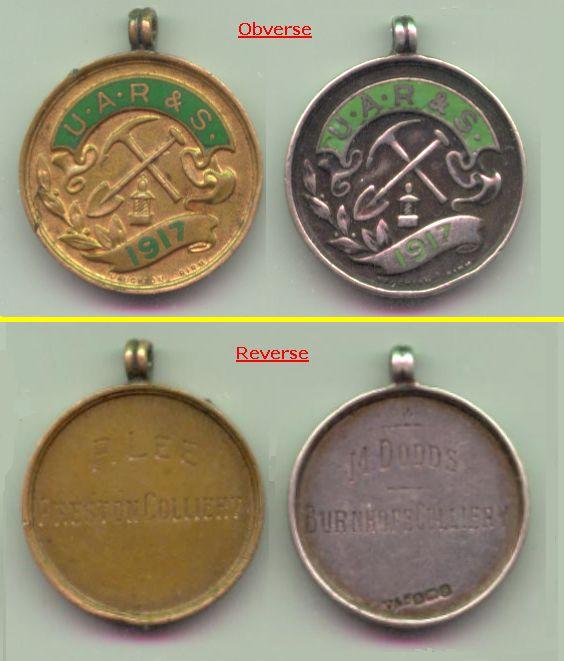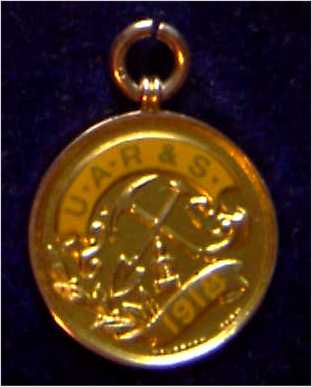The
Colliery Medallions of U. A. Ritson & Sons Ltd. of Co. Durham and
Northumberland
Does
anyone have any information about the types of medals or fobs illustrated
below. The examples illustrated have both been produced from the same die
and measure 26 mm diameter. The first, engraved on the reverse to "P.
Lee" of Preston Colliery (North Shields), appears to be of gilt
base metal while the second, engraved "M. Dobbs" of Burnhope
Colliery (County Durham), is of hallmarked (Birmingham, 1917) silver.
Both bear the signature of the makers Vaughton & Sons of Birmingham,
in small embossed letters on their obverse.

Over the past few
years I have come across at least four of these medals/fobs. Two examples, one
gilt the other silver, have been issued to men from Burnhope Colliery a third
to a man from Preston Colliery and a fourth to an unknown recipient of
South Pontop Colliery. Each of the four examples known to me have had the
same obverse design with a crossed pick and shovel above a flame safety
lamp. Above in green enamelled letters are the initials "U.A.R
& S" while below the date (also in green enamel) "1917".
Given
the list of collieries from which these medals have emanated it is possible to
identify the initials on their obverse as being those of the colliery owners
U.A. Ritson & Sons Ltd. At the time the medals appear to have been issued
(i.e. 1917) Ritsons owned three collieries - Burnhope and South
Pontop in Durham plus Preston on the Northumberland side of the
Tyne.
On first
encountering these fobs I believed them to be tribute medals issued by Ritsons
to colliers who had been in their employ who had served in the Great War.
Similar tribute medals are known to have been issued by other coal owners,
examples of which include the Wath Coal Company, Mitchell Main
Colliery Company and Rosslyn Collieries in Fife. However, if the
fobs were tribute medals why wasn't the date on their obverse not stated
more generally as 1914 - 18 or alternatively either 1918 or 1919. What was the
significance of the year 1917? An alternative suggestion was that the
medals may have been issued in tribute to colliers who had all signed up
for military service during one of the major government enlistment
campaigns instigated towards the end of the war (i.e. 1917) when new recruits
were urgently needed. What ever the exact explanation I felt sure the
fobs were some sort of Great War tribute medal. This was the belief I had held
for several years until very recently when I had to totally dismiss my
previous assumptions. Knowing of my interest in the Ritson medals a
fellow collector in County Durham contacted me to say that he had just
acquired a "Roll of Honour" issued by U.A. Ritson & Sons Ltd.
listing the names of all their employees who had served in the Great War 1914
to 1918. The roll of honour, like similar ones I have seen issued by
other colliery companies, gives details for each man listed such as his
military regiment and rank etc., which pit he had served at before enlisting
plus whether or not he was injured (fatally or not) or served for any period
as a POW.
Armed with the
names of the three individuals (J. Hopkins and M. Dobbs of Burnhope Colliery
plus P. Lee of Preston Colliery) for whom I knew had been issued with Ritson
medals all that was now need was to find their listings in the "Roll
of Honour" to prove my previous assumptions as to the medals' function.
Unfortunately none of theses individuals could be found listed anywhere and as
such their was no basis what so ever for regarding the fobs as Great War
tribute medals. So if not tribute medals what were the Ritson medals issued
for and why were they produced in both gilt and solid silver varieties? Any
suggestions would be greatly appreciated.
Submitted By : Mark Smith
Date: December 2002
REPLY
No.1
I
have one of the Ritson medals referenced above. While displaying this item on
my Durham Coalfield Memorabilia Display at the Durham Miners' Gala last year a
gentleman approached me after recognising the Ritson Medal in one of my
display cases. The gentleman claimed to be a native of Burnhope where many of
these medals must have originated. He claimed to have a similar medal in his
own possession a reported to have researched the item. The gentleman reported
the medals to be a 50 years long service medals issued to miners in Ritson's
employ, presumably around the year 1917. Unfortunately he disappeared back
into the crowd before any further details could be obtained off him.
Submitted
By: John Kitching (Webmaster plus Curator of the Brandon & Byshottles Archive)
Date:
April 2003
Response to
Reply 1
I think the idea of
these medals being long service tributes issued by Ritson's to there various
employers in Co. Durham and Northumberland is very plausible other than the
one fact that the design of all of them incorporates the specific dated of
1917. If they were general issue long service medals they wouldn't all be
dated the same? Surely the date must have specific meaning as regards
the fundamental reason for the medals' issue. (Mark Smith)
REPLY No.2
I
also don't believe these items are tribute medals. However, they may possibly
have served one of the following suggested purposes;
A)
They may have been possibly issued to commemorate an anniversary of the
company which occur in 1917 such as the occasion of its 25th or 50th year of
operations?
B) They could have been presented by the company to men in their employ who
had had to return home owing to injury during the Great War. I have seen
similar silver wounded medals issued by other British companies of the period.
C)
They
may have been a form of company war service badge. Such badges are known to
have been issued by various armaments factories and ship yards etc. during the
Great War. They indicated that the owners were serving their country and not
dodging war service or conscription, which commenced in 1916. The different
types of medal may have been to distinguish the different mines under Ritson's
ownership?
Submitted
By: Robert Watt
Date:
February 2004
REPLY No.3
I
also have one of the U.A.R.&S medals that is similar to the ones shown above.
It belonged to a member of my wife's family, Mr. J. O. Kirkup, and is
inscribed with his name plus that of "Burnhope Colliery" where he presumably
worked.
Mr. Kirkup was born in 1893 and died in 1954 and was from a family of miners
who lived in the Chester-le-Street district. His medal is still housed in the
Vaughton's
presentation case in which it was originally issued. However, this particular
medal (see image below) is different to the others so far discussed in that
it;
-
Is struck in hallmarked gold
(Birmingham 1918)
-
It carries the date of 1918 (instead
of the usual 1917) on its obverse
-
Has yellow or mustard coloured
inlayed enamel

Unfortunately this particular medal does not help answer any of the original
questions raised about this particular series of issues. In fact if anything
it has added to the mystery in that it is now apparent that not all the medals
bear the date of 1917 and that at least one other date (i.e. 1918) is
commemorated on them. What the significance is of this medal being struck in
solid gold is also a mystery. There would appear to be a hierarchy of medals
from gold, silver to gilt base metal. The significances of this is also a
mystery.
Submitted
By: James Elder
Date:
May 2005
If you can provide
any further information about the above items then please contact us via
the e-mail reply link below.
Previous
Home


